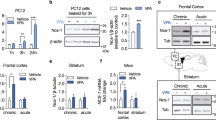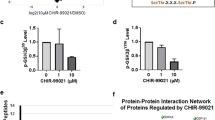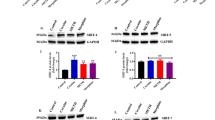ABSTRACT
Valproic acid (VPA), used to treat bipolar mood disorder and seizures, also inhibits histone deacetylase (HDAC). Here, we found that VPA and other HDAC inhibitors, butyrate and trichostatin A, robustly protected mature cerebellar granule cell cultures from excitotoxicity induced by SYM 2081 ((2S, 4R)-4-methylglutamate), an inhibitor of excitatory amino-acid transporters and an agonist of low-affinity kainate receptors. These neuroprotective effects required protracted treatment and were correlated with enhanced acetylated histone levels, indicating HDAC inhibition. SYM-induced excitotoxicity was blocked by MK-801 ((5R,10S)-(+)-5-methyl-10,11-dihydro-5H-dibenzo[a,d]cyclohepten-5,10-imine hydrogen maleate), supporting that the toxicity was largely N-methyl-D-aspartate receptor dependent. SYM excitotoxicity had apoptotic characteristics and was prevented by a caspase inhibitor. SYM-induced apoptosis was associated with a rapid and robust nuclear accumulation of glyceraldehyde-3-phosphate dehydrogenase (GAPDH), a housekeeping gene previously shown to be proapoptotic. VPA pretreatment suppressed SYM 2081-induced GAPDH nuclear accumulation, concurrent with its neuroprotective effects. Chromatin immunoprecipitation (ChIP) revealed that GAPDH is copresent with acetylated histone H3, including Lys9-acetylated histone, and that VPA treatment caused a time-dependent decrease in the levels of nuclear GAPDH with a concomitant increase in acetylated histones in the ChIP complex. Our results strongly suggest that VPA protects neurons from excitotoxicity through inhibition of HDAC activity and that this protective effect may involve suppression of excitotoxicity-induced accumulation of GAPDH protein in the nucleus.
This is a preview of subscription content, access via your institution
Access options
Subscribe to this journal
Receive 6 print issues and online access
$259.00 per year
only $43.17 per issue
Buy this article
- Purchase on Springer Link
- Instant access to full article PDF
Prices may be subject to local taxes which are calculated during checkout






Similar content being viewed by others
Abbreviations
- Ac-DEVD-CHO:
-
Ac-Asp-Glu-Val-Asp-CHO
- AMPA:
-
α-amino-3-hydroxy-5-methylisoxazole-4-propionic acid
- CGC:
-
cerebellar granule cells
- CNQX:
-
6-cyano-7-nitroquinoxaline-2,3-dione
- DAPI:
-
4,6-diaminodiphenyl-2-phenylindole
- DIV:
-
day in vitro
- DMEM:
-
Dulbecco's modified Eagle's medium
- DTT:
-
dithiothreitol
- GABA:
-
γ-aminobutyric acid
- GAPDH:
-
glyceraldehyde-3-phosphate dehydrogenase
- GSK:
-
glycogen synthase kinase
- GYKI 52466:
-
2,3-benzodiazepine
- HDAC:
-
histone deacetylase
- MK-801:
-
(5R,10S)-(+)-5-methyl-10,11-dihydro-5H-dibenzo[a,d]cyclohepten-5,10-imine hydrogen maleate
- MTT:
-
3-(4,5-dimethylthiazol-2-yl)-2,5-diphenyl tetrazolium bromide
- NBQX:
-
1,2,3,4-tetrahydro-6-nitro-2,3-dioxo-benzo[f]quinoxaline-7-sulfonamide
- NMDA:
-
N-methyl-D-aspartate
- PMSF:
-
phenylmethylsulfonyl fluoride
- TSA:
-
trichostatin A (4,6-dimethyl-7-[p-dimethylaminophenyl]-7-oxohepta-2,4-dieno-hydroxamic acid)
- VPA:
-
valproic acid
References
Johannessen CU . Mechanisms of action of valproate: a commentatory. Neurochem Int 2000; 37: 103–110.
Post RM, Speer AM, Obrocea GV, Leverich GS . Acute and prophylactic effects of anticonvulsants in bipolar depression. Clin Neurosci Res 2002; 2: 208–251.
Phiel CJ, Zhang F, Huang EY, Guenther MG, Lazar MA, Klein PS . Histone deacetylase is a direct target of valproic acid, a potent anticonvulsant, mood stabilizer, and teratogen. J Biol Chem 2001; 276: 36734–36741.
Göttlicher M, Minucci S, Zhu P, Kramer OH, Schimpf A, Giavara S et al. Valproic acid defines a novel class of HDAC inhibitors inducing differentiation of transformed cells. EMBO J 2001; 20: 6969–6978.
Gray SG, Ekstrom TJ . The human histone deacetylase family. Exp Cell Res 2001; 262: 75–83.
Han JW, Ahn SH, Park SH, Wang SY, Bae GU, Seo DW et al. Apicidin, a histone deacetylase inhibitor, inhibits proliferation of tumor cells via induction of p21WAF1/Cip1 and gelsolin. Cancer Res 2000; 60: 6068–6074.
Medina V, Edmonds B, Young GP, James R, Appleton S, Zalewski PD . Induction of caspase-3 protease activity and apoptosis by butyrate and trichostatin A (inhibitors of histone deacetylase): dependence on protein synthesis and synergy with a mitochondrial/cytochrome c-dependent pathway. Cancer Res 1997; 57: 3697–3707.
Kwon SH, Ahn SH, Kim YK, Bae GU, Yoon JW, Hong S et al. Apicidin, a histone deacetylase inhibitor, induces apoptosis and Fas/Fas ligand expression in human acute promyelocytic leukemia cells. J Biol Chem 2002; 277: 2073–2080.
Ryu H, Lee J, Olofsson BA, Mwidau A, Deodoglu A, Escudero M et al. Histone deacetylase inhibitors prevent oxidative neuronal death independent of expanded polyglutamine repeats via an Sp1-dependent pathway. Proc Natl Acad Sci USA 2003; 100: 4281–4286.
Kang HL, Benzer S, Min KT . Life extension in Drosophila by feeding a drug. Proc Natl Acad Sci USA 2002; 99: 838–843.
Loy R, Tariot PN . Neuroprotective properties of valproate—potential benefit for AD and tauopathies. J Mol Neurosci 2002; 19: 303–307.
Bown CD, Wang JF, Young L . Increased expression of endoplasmic reticulum stress proteins following chronic valproate treatment of rat C6 glioma cells. Neuropharmacology 2000; 39: 2162–2169.
Hall AC, Brennan A, Goold RG, Cleverley K, Lucas FR, Gordon-Weeks PR et al. Valproate regulates GSK-3-mediated axonal remodeling and synapsin I clustering in developing neurons. Mol Cell Neurosci 2002; 20: 257–270.
Vandenberg RJ, Mitrovic AD, Chebib M, Balcar VJ, Johnston GAR . Contrasting modes of action of methylglutamate derivatives on the excitatory amino acid transporters, EAAT1 and EAAT2. Mol Pharmacol 1997; 51: 809–815.
Donevan SD, Beg A, Gunther JM, Twyman RE . The methylglutamate, SYM 2081, is a potent and highly selective agonist at kainate receptors. J Pharmacol Exp Ther 1998; 285: 539–545.
Chen RW, Saunders PA, Wei H, Li Z, Seth P, Chuang D-M . Involvement of glyceraldehyde-3-phosphate dehydrogenase (GAPDH) and p53 in neuronal apoptosis: evidence that GAPDH is upregulated by p53. J Neurosci 1999; 19: 9654–9662.
Wells J, Farnham PJ . Characterizing transcription factor binding sites using formaldehyde crosslinking and immunoprecipitation. Methods 2002; 26: 48–56.
Ishitani R, Chuang D-M . Glyceraldehyde-3-phosphate dehydrogenase antisense oligodeoxynucleotides protect against cytosine arabinonucleoside-induced apoptosis in cultured cerebellar neurons. Proc Natl Acad Sci USA 1996; 93: 9937–9941.
Saunders PA, Chalecka-Franaszek E, Chuang D-M . Subcellular distribution of glyceraldehyde-3-phosphate dehydrogenase in cerebellar granule cells undergoing cytosine arabinoside-induced apoptosis. J Neurochem 1997; 69: 1820–1828.
Sawa A, Khan AA, Hester LD, Snyder SH . Glyceraldehyde-3-phosphate dehydrogenase: nuclear translocation participates in neuronal and nonneuronal cell death. Proc Natl Acad Sci USA 1997; 94: 11669–11674.
Nonaka S, Hough C, Chuang D-M . Chronic lithium treatment robustly protects CNS neurons against excitotoxicity by inhibiting NMDA receptor-mediated calcium influx. Proc Natl Acad Sci USA 1998; 95: 2642–2647.
Berman FW, Lepage KT, Murray TF . Domoic acid neurotoxicity in cultured cerebellar granule neurons is controlled preferentially by the NMDA receptor Ca(2+) influx pathway. Brain Res 2002; 924: 20–29.
Ha BK, Vicini S, Rogers RC, Bresnahan JC, Buray RW, Beattie MS . Kainate-induced excitotoxicity is dependent upon extracellular potassium concentrations that regulate the activity of AMPA/KA type glutamate receptors. J Neurochem 2002; 83: 934–945.
Velasco I, Tapia R, Massieu L . Inhibition of glutamate uptake induces progressive accumulation of extracellular glutamate and neuronal damage in rat cortical cultures. J Neurosci Res 1998; 44: 551–561.
Chaudhry FA, Lehre KP, Campagne MV, Ottersen OP, Danbolt NC, Stormmathisen J . Glutamate transporters in glial plasma-membranes—highly differentiated localizations revealed by quantitative ultrastructural immunocytochemistry. Neuron 1995; 15: 711–720.
Mafra RA, Leao RM, Beirao PSL, Cruz JS . Electrophysiological evidence for glial-subtype glutamate transporter functional expression in rat cerebellar granule neurons. Braz J Med Biol Res 2003; 36: 951–957.
Saunders PA, Chen RW, Chuang D-M . Nuclear translocation of glyceraldehyde-3-phosphate dehydrogenase isoforms during neuronal apoptosis. J Neurochem 1999; 72: 925–932.
Carlile GW, Chalmers-Redman RME, Tatton NA, Pong A, Borden KE, Tatton WG . Reduced apoptosis after nerve growth factor and serum withdrawal: conversion of tetrameric glyceraldehyde-3-phosphate dehydrogenase to a dimer. Mol Pharmacol 2000; 57: 2–12.
Krynetski EY, Kryneskaia NF, Gallo AE, Murti KG, Evans WE . A novel protein complex distinct from mismatch repair binds thioguanylated DNA. Mol Pharmacol 2001; 59: 367–374.
Brown VM, Krynetski EY, Krynetskaia NF, Grieger D, Mukatira ST, Murti KG et al. A novel CRM1-mediated nuclear export signal governs nuclear accumulation of glyceraldehyde-3-phosphate dehydrogenase following genotoxic stress. J Biol Chem 2004; 279: 5984–5992.
Zheng L, Roeder RG, Luo Y . S phase activation of the histone H2B promoter by OCA-S, a coactivator complex that contains GAPDH as a key component. Cell 2003; 114: 255–266.
Burke JR, Enghild JJ, Martin ME, Jou YS, Myers RM, Roses AD et al. Huntingtin and DRPLA proteins selectively interact with the enzyme GAPDH. Nat Med 1996; 2: 347–350.
Senatorov VV, Charles V, Reddy PH, Tagle DA, Chuang D-M . Overexpression and nuclear accumulation of glyceraldehyde-3-phosphate dehydrogenase in a transgenic mouse model of Huntington's disease. Mol Cell Neurosci 2003; 22: 285–297.
Steffan JS, Bodai L, Pallos J, Poelman M, McCampbell A, Apostol BL et al. Histone deacetylase inhibitors arrest polyglutamine-dependent neurodegeneration in Drosophila. Nature 2001; 413: 739–743.
Zhang CL, Mckinsey TA, Olson EN . Association of class II histone deacetylases with heterochromatin protein 1: potential role for histone methylation in control of muscle differentiation. Mol Cell Biol 2002; 22: 7302–7312.
Tremolizzo L, Carboni G, Ruzicka WB, Mitchell CP, Sugaya I, Tueting P et al. An epigenetic mouse model for molecular and behavioral neuropathologies related to schizophrenia vulnerability. Proc Natl Acad Sci USA 2002; 99: 17095–17100.
Yildirim E, Zhang Z, Uz T, Chen C-Q, Manev R, Manev H . Valproate administration to mice increases histone acetylation and 5-lipoxygenase content in the hippocampus. Neurosci Lett 2003; 345: 141–143.
Chen G, Zeng WZ, Yuan PX, Huang LD, Jiang YM, Zhao ZH et al. The mood-stabilizing agents lithium and valproate robustly increase the levels of the neuroprotective protein bcl-2 in the CNS. J Neurochem 1999; 72: 879–882.
Bown CD, Wang JF, Chen B, Young LT . Regulation of ER stress proteins by valproate: therapeutic implications. Bipolar Disord 2002; 4: 145–151.
Jeong MR, Hashimoto R, Senatorov VV, Fujimaki K, Ren M, Lee MS et al. Valproic acid, a mood stabilizer and anticonvulsant, protects rat cerebral cortical neurons from spontaneous cell death: a role of histone deacetylase inhibition. FEBS Lett 2003; 542: 74–78.
Ren M, Leng Y, Jeong MR, Leeds PR, Chuang D-M. Valproic acid reduces brain damage induced by transient focal cerebral ischemia in rats: potential roles of histone deacetylase inhibition and heat shock protein induction. J Neurochem 2004; 89: 1358–1367.
Fukumoto T, Morinobu S, Okamoto Y, Kagaya A, Yamawaki S . Chronic lithium treatment increases the expression of brain-derived neurotrophic factor in the rat brain. Psychopharmacology (Berl) 2001; 158: 100–106.
Acknowledgements
We thank Lori Christ in our Section of NIMH, NIH, as well as Yang-Ja Lee-Wickner and Mariusz Karbowski of NINDS for their technical assistance and advice.
Author information
Authors and Affiliations
Corresponding author
Additional information
DUALITY OF INTEREST
None declared.
Rights and permissions
About this article
Cite this article
Kanai, H., Sawa, A., Chen, RW. et al. Valproic acid inhibits histone deacetylase activity and suppresses excitotoxicity-induced GAPDH nuclear accumulation and apoptotic death in neurons. Pharmacogenomics J 4, 336–344 (2004). https://doi.org/10.1038/sj.tpj.6500269
Received:
Revised:
Accepted:
Published:
Issue Date:
DOI: https://doi.org/10.1038/sj.tpj.6500269
Keywords
This article is cited by
-
Transient plasticity response is regulated by histone deacetylase inhibitor in oxygen–glucose deprivation condition
Pharmacological Reports (2023)
-
The role of picornavirus infection in epileptogenesis
Acta Epileptologica (2021)
-
Assessment of behavioral, morphological and electrophysiological changes in prenatal and postnatal valproate induced rat models of autism spectrum disorder
Scientific Reports (2021)
-
Arundic Acid Increases Expression and Function of Astrocytic Glutamate Transporter EAAT1 Via the ERK, Akt, and NF-κB Pathways
Molecular Neurobiology (2018)
-
Dissecting bipolar disorder complexity through epigenomic approach
Molecular Psychiatry (2016)



